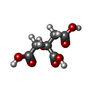Entry Database : PDB / ID : 7lgsTitle Structure of EGFR_D770_N771insNPG/V948R in complex with covalent inhibitor Osimertinib. Epidermal growth factor receptor Keywords / / / / / Function / homology Function Domain/homology Component
/ / / / / / / / / / / / / / / / / / / / / / / / / / / / / / / / / / / / / / / / / / / / / / / / / / / / / / / / / / / / / / / / / / / / / / / / / / / / / / / / / / / / / / / / / / / / / / / / / / / / / / / / / / / / / / / / / / / / / / / / / / / / / / / / / / / / / / / / / / / / Biological species Homo sapiens (human)Method / / / Resolution : 3.1 Å Authors Skene, R.J. / Lane, W. Journal : Cancer Discov / Year : 2021Title : Mobocertinib (TAK-788): A Targeted Inhibitor of EGFR Exon 20 Insertion Mutants in Non-Small Cell Lung Cancer.Authors: Gonzalvez, F. / Vincent, S. / Baker, T.E. / Gould, A.E. / Li, S. / Wardwell, S.D. / Nadworny, S. / Ning, Y. / Zhang, S. / Huang, W.S. / Hu, Y. / Li, F. / Greenfield, M.T. / Zech, S.G. / Das, ... Authors : Gonzalvez, F. / Vincent, S. / Baker, T.E. / Gould, A.E. / Li, S. / Wardwell, S.D. / Nadworny, S. / Ning, Y. / Zhang, S. / Huang, W.S. / Hu, Y. / Li, F. / Greenfield, M.T. / Zech, S.G. / Das, B. / Narasimhan, N.I. / Clackson, T. / Dalgarno, D. / Shakespeare, W.C. / Fitzgerald, M. / Chouitar, J. / Griffin, R.J. / Liu, S. / Wong, K.K. / Zhu, X. / Rivera, V.M. History Deposition Jan 21, 2021 Deposition site / Processing site Revision 1.0 Sep 22, 2021 Provider / Type Revision 1.1 Oct 18, 2023 Group / Refinement descriptionCategory / chem_comp_bond / pdbx_initial_refinement_model
Show all Show less
 Yorodumi
Yorodumi Open data
Open data Basic information
Basic information Components
Components
 Keywords
Keywords Kinase /
Kinase /  inhibitor /
inhibitor /  covalent /
covalent /  HYDROLASE / HYDROLASE-HYDROLASE inhibitor complex
HYDROLASE / HYDROLASE-HYDROLASE inhibitor complex Function and homology information
Function and homology information multivesicular body, internal vesicle lumen / positive regulation of prolactin secretion / negative regulation of cardiocyte differentiation / positive regulation of protein kinase C activity / diterpenoid metabolic process / Shc-EGFR complex /
multivesicular body, internal vesicle lumen / positive regulation of prolactin secretion / negative regulation of cardiocyte differentiation / positive regulation of protein kinase C activity / diterpenoid metabolic process / Shc-EGFR complex /  ovulation cycle / Inhibition of Signaling by Overexpressed EGFR /
ovulation cycle / Inhibition of Signaling by Overexpressed EGFR /  epidermal growth factor receptor activity ...response to hydroxyisoflavone /
epidermal growth factor receptor activity ...response to hydroxyisoflavone /  multivesicular body, internal vesicle lumen / positive regulation of prolactin secretion / negative regulation of cardiocyte differentiation / positive regulation of protein kinase C activity / diterpenoid metabolic process / Shc-EGFR complex /
multivesicular body, internal vesicle lumen / positive regulation of prolactin secretion / negative regulation of cardiocyte differentiation / positive regulation of protein kinase C activity / diterpenoid metabolic process / Shc-EGFR complex /  ovulation cycle / Inhibition of Signaling by Overexpressed EGFR /
ovulation cycle / Inhibition of Signaling by Overexpressed EGFR /  epidermal growth factor receptor activity / EGFR interacts with phospholipase C-gamma / positive regulation of mucus secretion / response to UV-A /
epidermal growth factor receptor activity / EGFR interacts with phospholipase C-gamma / positive regulation of mucus secretion / response to UV-A /  epidermal growth factor binding / PLCG1 events in ERBB2 signaling / tongue development / midgut development / ERBB2-EGFR signaling pathway / hydrogen peroxide metabolic process / PTK6 promotes HIF1A stabilization / digestive tract morphogenesis /
epidermal growth factor binding / PLCG1 events in ERBB2 signaling / tongue development / midgut development / ERBB2-EGFR signaling pathway / hydrogen peroxide metabolic process / PTK6 promotes HIF1A stabilization / digestive tract morphogenesis /  regulation of nitric-oxide synthase activity / morphogenesis of an epithelial fold / ERBB2 Activates PTK6 Signaling / intracellular vesicle / Signaling by EGFR / response to cobalamin /
regulation of nitric-oxide synthase activity / morphogenesis of an epithelial fold / ERBB2 Activates PTK6 Signaling / intracellular vesicle / Signaling by EGFR / response to cobalamin /  transmembrane receptor protein tyrosine kinase activator activity / protein tyrosine kinase activator activity / negative regulation of epidermal growth factor receptor signaling pathway / Signaling by ERBB4 / regulation of phosphatidylinositol 3-kinase/protein kinase B signal transduction / eyelid development in camera-type eye / protein insertion into membrane / cerebral cortex cell migration / ERBB2 Regulates Cell Motility / regulation of JNK cascade / : / PI3K events in ERBB2 signaling / positive regulation of cyclin-dependent protein serine/threonine kinase activity / negative regulation of mitotic cell cycle / hair follicle development /
transmembrane receptor protein tyrosine kinase activator activity / protein tyrosine kinase activator activity / negative regulation of epidermal growth factor receptor signaling pathway / Signaling by ERBB4 / regulation of phosphatidylinositol 3-kinase/protein kinase B signal transduction / eyelid development in camera-type eye / protein insertion into membrane / cerebral cortex cell migration / ERBB2 Regulates Cell Motility / regulation of JNK cascade / : / PI3K events in ERBB2 signaling / positive regulation of cyclin-dependent protein serine/threonine kinase activity / negative regulation of mitotic cell cycle / hair follicle development /  MAP kinase kinase kinase activity / Estrogen-dependent nuclear events downstream of ESR-membrane signaling / embryonic placenta development / positive regulation of bone resorption / positive regulation of G1/S transition of mitotic cell cycle / GAB1 signalosome / positive regulation of nitric oxide mediated signal transduction / salivary gland morphogenesis / peptidyl-tyrosine autophosphorylation / regulation of peptidyl-tyrosine phosphorylation / positive regulation of phosphorylation / positive regulation of glial cell proliferation / positive regulation of vasoconstriction / Signaling by ERBB2 / cellular response to epidermal growth factor stimulus / cellular response to cadmium ion / GRB2 events in EGFR signaling / SHC1 events in EGFR signaling / positive regulation of DNA repair / EGFR Transactivation by Gastrin / GRB2 events in ERBB2 signaling / TFAP2 (AP-2) family regulates transcription of growth factors and their receptors /
MAP kinase kinase kinase activity / Estrogen-dependent nuclear events downstream of ESR-membrane signaling / embryonic placenta development / positive regulation of bone resorption / positive regulation of G1/S transition of mitotic cell cycle / GAB1 signalosome / positive regulation of nitric oxide mediated signal transduction / salivary gland morphogenesis / peptidyl-tyrosine autophosphorylation / regulation of peptidyl-tyrosine phosphorylation / positive regulation of phosphorylation / positive regulation of glial cell proliferation / positive regulation of vasoconstriction / Signaling by ERBB2 / cellular response to epidermal growth factor stimulus / cellular response to cadmium ion / GRB2 events in EGFR signaling / SHC1 events in EGFR signaling / positive regulation of DNA repair / EGFR Transactivation by Gastrin / GRB2 events in ERBB2 signaling / TFAP2 (AP-2) family regulates transcription of growth factors and their receptors /  transmembrane receptor protein tyrosine kinase activity / SHC1 events in ERBB2 signaling /
transmembrane receptor protein tyrosine kinase activity / SHC1 events in ERBB2 signaling /  ossification / positive regulation of synaptic transmission, glutamatergic /
ossification / positive regulation of synaptic transmission, glutamatergic /  neurogenesis / cellular response to dexamethasone stimulus / basal plasma membrane / regulation of ERK1 and ERK2 cascade / neuron projection morphogenesis / positive regulation of superoxide anion generation / positive regulation of DNA replication / Signal transduction by L1 / epithelial cell proliferation / cellular response to estradiol stimulus / NOTCH3 Activation and Transmission of Signal to the Nucleus / positive regulation of epithelial cell proliferation / astrocyte activation /
neurogenesis / cellular response to dexamethasone stimulus / basal plasma membrane / regulation of ERK1 and ERK2 cascade / neuron projection morphogenesis / positive regulation of superoxide anion generation / positive regulation of DNA replication / Signal transduction by L1 / epithelial cell proliferation / cellular response to estradiol stimulus / NOTCH3 Activation and Transmission of Signal to the Nucleus / positive regulation of epithelial cell proliferation / astrocyte activation /  liver regeneration / positive regulation of protein localization to plasma membrane / EGFR downregulation /
liver regeneration / positive regulation of protein localization to plasma membrane / EGFR downregulation /  cell surface receptor protein tyrosine kinase signaling pathway / cellular response to amino acid stimulus / positive regulation of smooth muscle cell proliferation / Signaling by ERBB2 TMD/JMD mutants / positive regulation of MAP kinase activity / clathrin-coated endocytic vesicle membrane / lung development / Constitutive Signaling by EGFRvIII / Signaling by ERBB2 ECD mutants / epidermal growth factor receptor signaling pathway / Signaling by ERBB2 KD Mutants / negative regulation of protein catabolic process /
cell surface receptor protein tyrosine kinase signaling pathway / cellular response to amino acid stimulus / positive regulation of smooth muscle cell proliferation / Signaling by ERBB2 TMD/JMD mutants / positive regulation of MAP kinase activity / clathrin-coated endocytic vesicle membrane / lung development / Constitutive Signaling by EGFRvIII / Signaling by ERBB2 ECD mutants / epidermal growth factor receptor signaling pathway / Signaling by ERBB2 KD Mutants / negative regulation of protein catabolic process /  receptor protein-tyrosine kinase / Downregulation of ERBB2 signaling /
receptor protein-tyrosine kinase / Downregulation of ERBB2 signaling /  kinase binding / ruffle membrane
kinase binding / ruffle membrane
 Homo sapiens (human)
Homo sapiens (human) X-RAY DIFFRACTION /
X-RAY DIFFRACTION /  SYNCHROTRON /
SYNCHROTRON /  MOLECULAR REPLACEMENT / Resolution: 3.1 Å
MOLECULAR REPLACEMENT / Resolution: 3.1 Å  Authors
Authors Citation
Citation Journal: Cancer Discov / Year: 2021
Journal: Cancer Discov / Year: 2021 Structure visualization
Structure visualization Molmil
Molmil Jmol/JSmol
Jmol/JSmol Downloads & links
Downloads & links Download
Download 7lgs.cif.gz
7lgs.cif.gz PDBx/mmCIF format
PDBx/mmCIF format pdb7lgs.ent.gz
pdb7lgs.ent.gz PDB format
PDB format 7lgs.json.gz
7lgs.json.gz PDBx/mmJSON format
PDBx/mmJSON format Other downloads
Other downloads https://data.pdbj.org/pub/pdb/validation_reports/lg/7lgs
https://data.pdbj.org/pub/pdb/validation_reports/lg/7lgs ftp://data.pdbj.org/pub/pdb/validation_reports/lg/7lgs
ftp://data.pdbj.org/pub/pdb/validation_reports/lg/7lgs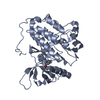
 Links
Links Assembly
Assembly




 Components
Components / Proto-oncogene c-ErbB-1 / Receptor tyrosine-protein kinase erbB-1
/ Proto-oncogene c-ErbB-1 / Receptor tyrosine-protein kinase erbB-1
 Homo sapiens (human) / Gene: EGFR, ERBB, ERBB1, HER1 / Production host:
Homo sapiens (human) / Gene: EGFR, ERBB, ERBB1, HER1 / Production host:  Baculoviridae sp. (virus)
Baculoviridae sp. (virus) receptor protein-tyrosine kinase
receptor protein-tyrosine kinase Ethylene glycol
Ethylene glycol Citric acid
Citric acid Water
Water X-RAY DIFFRACTION / Number of used crystals: 1
X-RAY DIFFRACTION / Number of used crystals: 1  Sample preparation
Sample preparation
 SYNCHROTRON / Site:
SYNCHROTRON / Site:  ALS
ALS  / Beamline: 5.0.3 / Wavelength: 0.987 Å
/ Beamline: 5.0.3 / Wavelength: 0.987 Å : 0.987 Å / Relative weight: 1
: 0.987 Å / Relative weight: 1  Processing
Processing :
:  MOLECULAR REPLACEMENT
MOLECULAR REPLACEMENT Movie
Movie Controller
Controller















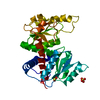
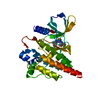



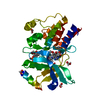
 PDBj
PDBj
















